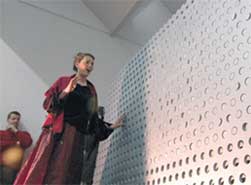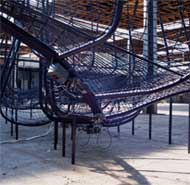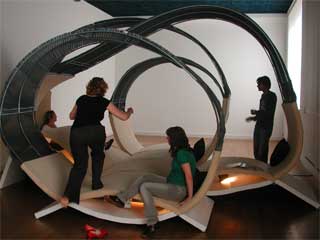Liquid 2.0, by Daan Roosegaarde, is an interactive living cocoon which physically reacts to your motion and sounds. According to the intensity of human behavior Liquid 2.0 becomes bigger and smaller, with an amplitude of half a meter.
The project was officially launched in 2003 with Liquid Space, the first in a serie of interactive objects the architect realized. “While studying architecture I became annoyed with the fact that the ingredients of space usely remained limited to bricks, windows and doors,” explains Roosegaarde. “I am longing for a space which reacts in real-time and participates with its users.”


Two previous projects: 4D-Pixel Interactive Wall and Liquid Space
Through many collaborations with software engineers, material manufactures and cultural foundations, the projects actually got a chance to be realized. One of them, 4D-Pixel, is a wall which physically reacts to your voice.
“All installations are shown at new media exhibitions in Europe. These shows are good testing grounds to see what works and what dies in terms of interaction,” he adds. “This is important since the main ingredient of the installations is the interaction itself. At the same time these events create a mental platform for the projects to be launched in the next phase; implementation into architecture and public space.”
 Although Daan Roosegaarde decided to give the installation a non-threatening, low-tech look, it is packed with technology. Liquid 2.0 detects the human activity through motion sensors and microphones. This data is processed by a C++ software. The mechanism consist of linear actuators which have low sound and high power. The sculpture is made out of four autonomous modules, each with their own mechanism and processing power. This makes it possible to expand the object by adding more modules.
Although Daan Roosegaarde decided to give the installation a non-threatening, low-tech look, it is packed with technology. Liquid 2.0 detects the human activity through motion sensors and microphones. This data is processed by a C++ software. The mechanism consist of linear actuators which have low sound and high power. The sculpture is made out of four autonomous modules, each with their own mechanism and processing power. This makes it possible to expand the object by adding more modules.
Visitors first see a large sculpture in the middle of the room. As they come closer, the object is activated by the sensors and the first cocoon starts to open up with an amplitude of 70 cm. Most people get startled but when they recover some confidence, they enter the space.
“At one moment during the premiere opening 9 people were lounging away which made the space smaller and intimate,” recalls the architect. “Also the space had its own will; so if you were sitting too long inside be prepared to get a nice ‘wake-up call’. The moment somebody new entered it lifted up its roof to make more space for the new inhabitant. The fact that when you enter the installation becomes bigger is a fascinating experience. It results in an object which, although filled with new media, seems ‘natural’ for the visitor, as an extension of their skin. ‘Natural’, of course, in a 21 century way.”
He concludes: “What I like about these projects is that there is a form which is capable of handling different inputs at the same time; sometimes being agressive, sometimes being sensual. It’s alive and kicking.”
All images courtesy of Daan Roosegaarde.
Liquid 2.0 is part of the 5 days off/Sensorium exhibition, a collection of installations and live performances housed at the media institute Montevideo in Amsterdam until July 16.
Other “living” architecture pieces: Angels, Tomas Saraceno’s floating Utopia, Responsive architecture, The MuscleBody, Reciprocal Space.
